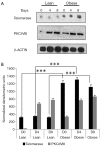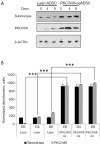Protein kinase C delta (PKCδ) splice variant modulates senescence via hTERT in adipose-derived stem cells
- PMID: 27358850
- PMCID: PMC4923498
- DOI: 10.3978/j.issn.2306-9759.2014.01.02
Protein kinase C delta (PKCδ) splice variant modulates senescence via hTERT in adipose-derived stem cells
Abstract
Background: Adipose-derived stem cells (ADSC) were isolated and characterized from lean and obese subjects. We previously reported that distinct differences were observed in differentiating lean and obese preadipocytes. Protein kinase C delta (PKCδ) is alternatively spliced and has important roles in apoptosis. PKCδI promotes apoptosis and PKCδVIII promotes survival. Our previous data indicated an increase in the survival kinase, PKCδVIII in ADSC derived from an obese donor. We also determined that obese adipocytes were resistant to apoptosis. Here, we determine the relationship between a survival kinase PKCδVIII and hTERT expression in adipose derived stem cells from a lean and obese subject.
Methods: We evaluated the telomerase activity and human telomerase reverse transcriptase (hTERT) expression in lean and obese ADSC. The lean and obese ADSC were purchased as cryopreserved cells from ZenBio™ (Research Triangle Park, NC, USA). Analyses were performed using PRISM™ software and analyzed using two-tailed Student's t-test.
Results: We observed an increase in telomerase in differentiating obese ADSC using western blot analysis. We determined the levels of hTERT splice variants. hTERT α+/β+ splice variant was increased after transfected of PKCδVIII. We next determined whether PKCδVIII over-expression affected the levels of telomerase. The results indicate an increase in telomerase with PKCδVIII over-expression.
Conclusions: Over-expression of PKCδVIII in lean ADSC substantially increased expression of hTERT and telomerase. The decreased senescence seen in obese ADSC may in part be attributed to PKCδVIII. Obese ADSC undergo lower senescence and may have increased growth potential. These results propose a larger epigenetic modification in obese ADSC compared to lean ADSC.
Keywords: Adipose-derived stem cells (ADSC); alternative splicing; human telomerase reverse transcriptase (hTERT); obesity; protein kinase C delta (PKCδ).
Conflict of interest statement
Figures





Similar articles
-
Role of alternatively spliced, pro-survival Protein Kinase C delta VIII (PKCδVIII) in ovarian cancer.FASEB Bioadv. 2021 Dec 10;4(4):235-253. doi: 10.1096/fba.2021-00090. eCollection 2022 Apr. FASEB Bioadv. 2021. PMID: 35415459 Free PMC article.
-
Vitamin A metabolite, all-trans-retinoic acid, mediates alternative splicing of protein kinase C deltaVIII (PKCdeltaVIII) isoform via splicing factor SC35.J Biol Chem. 2010 Aug 20;285(34):25987-95. doi: 10.1074/jbc.M110.100735. Epub 2010 Jun 14. J Biol Chem. 2010. PMID: 20547768 Free PMC article.
-
Identification of a novel antiapoptotic human protein kinase C delta isoform, PKCdeltaVIII in NT2 cells.Biochemistry. 2008 Jan 15;47(2):787-97. doi: 10.1021/bi7019782. Epub 2007 Dec 20. Biochemistry. 2008. PMID: 18092819
-
Alternative Splicing of Human Telomerase Reverse Transcriptase (hTERT) and Its Implications in Physiological and Pathological Processes.Biomedicines. 2021 May 9;9(5):526. doi: 10.3390/biomedicines9050526. Biomedicines. 2021. PMID: 34065134 Free PMC article. Review.
-
Physiological and pathological significance of human telomerase reverse transcriptase splice variants.Biochimie. 2013 Nov;95(11):1965-70. doi: 10.1016/j.biochi.2013.07.031. Epub 2013 Aug 9. Biochimie. 2013. PMID: 23933091 Review.
Cited by
-
Adipose-derived stem cells from lean and obese humans show depot specific differences in their stem cell markers, exosome contents and senescence: role of protein kinase C delta (PKCδ) in adipose stem cell niche.Stem Cell Investig. 2016 Jan 31;3:2. doi: 10.3978/j.issn.2306-9759.2016.01.02. eCollection 2016. Stem Cell Investig. 2016. PMID: 27358894 Free PMC article.
-
Reverse transcriptase and intron number evolution.Stem Cell Investig. 2014 Sep 28;1:17. doi: 10.3978/j.issn.2306-9759.2014.08.01. eCollection 2014. Stem Cell Investig. 2014. PMID: 27358863 Free PMC article.
-
A specific small-molecule inhibitor of protein kinase CδI activity improves metabolic dysfunction in human adipocytes from obese individuals.J Biol Chem. 2019 Oct 11;294(41):14896-14910. doi: 10.1074/jbc.RA119.008777. Epub 2019 Aug 14. J Biol Chem. 2019. PMID: 31413114 Free PMC article.
-
Role of alternatively spliced, pro-survival Protein Kinase C delta VIII (PKCδVIII) in ovarian cancer.FASEB Bioadv. 2021 Dec 10;4(4):235-253. doi: 10.1096/fba.2021-00090. eCollection 2022 Apr. FASEB Bioadv. 2021. PMID: 35415459 Free PMC article.
References
-
- Blackburn EH. Telomere states and cell fates. Nature 2000;408:53-6. - PubMed
-
- Ulaner GA, Hu JF, Vu TH, et al. Telomerase activity in human development is regulated by human telomerase reverse transcriptase (hTERT) transcription and by alternate splicing of hTERT transcripts. Cancer Res 1998;58:4168-72. - PubMed
-
- Ulaner GA, Hu JF, Vu TH, et al. Tissue-specific alternate splicing of human telomerase reverse transcriptase (hTERT) influences telomere lengths during human development. Int J Cancer 2001;91:644-9. - PubMed
LinkOut - more resources
Full Text Sources
